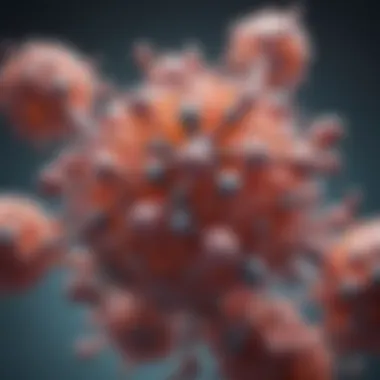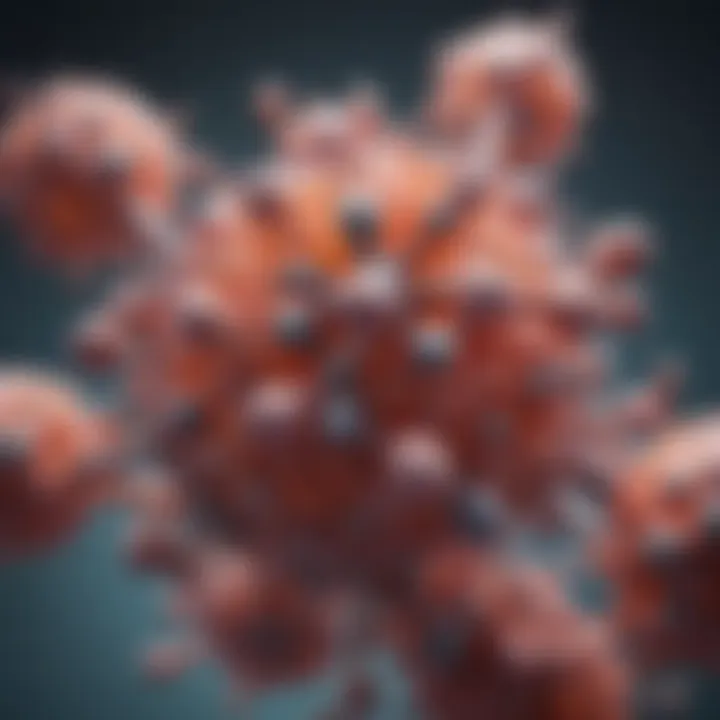Carboplatin and Etoposide in Lung Cancer Treatment


Intro
Lung cancer remains one of the leading causes of cancer-related deaths worldwide. In the fight against this formidable foe, treatments continue to evolve, with carboplatin and etoposide emerging as notable components of chemotherapy regimens. These two drugs, widely studied and utilized, offer a beacon of hope for patients battling this disease. However, understanding their mechanisms, applications, and potential side effects is essential for anyone involved in oncological care or research.
As we explore carboplatin and etoposide, we'll dive into their individual roles and how they can be strategically combined to bolster treatment efficacy. Recent advances in research shed light on new methodologies and treatment protocols, underscoring the importance of staying abreast of trends in the medical field. For students, researchers, and healthcare professionals, grasping these elements is not just academic; it directly impacts treatment outcomes for patients navigating the complexities of lung cancer.
Recent Advances
In the realm of lung cancer treatment, staying updated on recent advances is crucial. The ongoing research has significantly refined our approaches to chemotherapy, especially regarding the use of carboplatin and etoposide.
Latest Discoveries
Over the last few years, studies have revealed several promising findings in how these drugs can be leveraged. For instance, recent clinical trials indicated that administering carboplatin and etoposide concurrently with immunotherapy can enhance overall survival rates in patients facing advanced lung cancer. The interaction between these agents appears to stimulate the immune system, allowing it to recognize and combat cancer cells more effectively.
Moreover, insights into genetic biomarkers have prompted researchers to tailor treatment plans more individually. For example, identifying specific mutations can refine eligibility for carboplatin and etoposide therapy, improving outcomes.
Technological Innovations
Technological innovations also play a pivotal role in advancing treatment strategies. For instance, the advent of precision medicine has revolutionized how we approach lung cancer therapy. By utilizing techniques such as genomic sequencing, healthcare providers can make informed decisions regarding the effectiveness of carboplatin and etoposide based on patient-specific tumor profiles.
Another noteworthy advancement is the enhanced imaging technologies that facilitate better tracking of treatment response. Using positron emission tomography (PET) and advanced MRI techniques allows oncologists to monitor how well a patient responds to carboplatin and etoposide, thus leading to timely alterations in treatment if necessary.
In sum, the landscape of lung cancer therapy is shifting. Carboplatin and etoposide are at the forefront, evolving alongside our growing understanding of cancer biology and patient-specific care.
Methodology
Understanding the methodology used in studies involving carboplatin and etoposide is critical. It not only underpins the reliability of findings but also aids in discerning the contexts in which these therapies are most effective.
Research Design
The research designs employed in investigating the effectiveness of these drugs often include randomized controlled trials, observational studies, and meta-analyses. Randomized controlled trials, in particular, provide a robust framework to compare the outcomes of patients receiving the treatment against a control group without the treatment, ensuring that any observed differences can be attributed to the intervention itself.
Data Collection Techniques
Regarding data collection, methodologies might encompass patient surveys, clinical assessments, tumor marker evaluations, and imaging studies to gather comprehensive data on patient outcomes. Collectively, these techniques are instrumental in evaluating the efficacy of carboplatin and etoposide, allowing researchers and clinicians to make informed decisions based on substantial evidence.
Prolusion to Lung Cancer
Lung cancer stands as one of the most formidable foes in the realm of oncology, representing a leading cause of cancer-related deaths globally. The insights into lung cancer are not merely academic; they bear significant implications for public health policy, treatment advancements, and overall patient outcomes. This section emphasizes the profound importance of understanding lung cancer in light of the effectiveness of therapy options like carboplatin and etoposide. For students, researchers, and professionals, grappling with this disease’s intricacies is critical for developing innovative approaches to treatment.
Overview of Lung Cancer Types
Lung cancer primarily branches into two major types: small cell lung cancer (SCLC) and non-small cell lung cancer (NSCLC). SCLC, although less common, is known for its aggressive nature and rapid metastasis. It typically accounts for about 10-15% of all lung cancer cases, and is often linked to heavy smoking. On the other hand, non-small cell lung cancer, which represents approximately 85-90% of cases, can further be divided into several subtypes, including adenocarcinoma, squamous cell carcinoma, and large cell carcinoma. Each type exhibits unique cellular characteristics, growth patterns, and responses to treatment.
An understanding of these distinctions is integral; effective therapeutic strategies hinge on correctly identifying the cancer type. It helps to tailor treatment protocols, ensuring that patients receive the most suitable drugs, like carboplatin and etoposide, that can effectively combat the cancer’s specific profile.
Epidemiology of Lung Cancer
Understanding the epidemiology of lung cancer—its occurrence and impact on different populations—is crucial in the fight against this disease. Lung cancer carries a heavy burden, affecting millions worldwide. According to data from the American Cancer Society, in 2023 alone, an estimated 239,000 new cases of lung cancer are expected in the United States, with a staggering mortality rate.
Several factors contribute to the prevalence of lung cancer. Smoking remains the leading risk factor. However, environmental toxins, genetic predisposition, and even air pollution play a significant role in increasing the risks. Interestingly, recent trends show a rising incidence in non-smokers, particularly among women and younger populations, indicating a shift that demands attention in both research and treatment planning.
"Epidemiological trends highlight the need for tailored public health initiatives and effective strategies to curb the lung cancer epidemic."
It becomes ever more essential to recognize high-risk groups, enabling proactive measures in screening and prevention strategies. This understanding will facilitate the development of treatments like carboplatin and etoposide that could potentially improve patient outcomes across diverse demographics. Overall, delving into the complexities of lung cancer paves the way for targeted and effective therapies, enhancing the fight against this pervasive illness.
Mechanisms of Action
Understanding the mechanisms of action behind carboplatin and etoposide is crucial for grasping how these agents work in lung cancer treatment. Not only does it shed light on their therapeutic benefits, but it also points out their potential limitations and provides insights into future treatment advancements.
Understanding Carboplatin
Chemical Structure
Carboplatin's chemical structure is one of its distinguishing features. It belongs to the platinum-based class of chemotherapeutic agents. The structural similarities between carboplatin and its precursor, cisplatin, give rise to similar, albeit slightly different, properties. Its ability to form DNA cross-links is pivotal, affecting how cancer cells replicate. This property makes carboplatin a popular choice because it is generally less toxic compared to cisplatin and doesn’t induce as severe side effects like nephrotoxicity.
One unique aspect of carboplatin is its amine-based chemical groups, which enhance solubility, allowing for easier administration through intravenous routes. However, this advantage doesn't come without a trade-off; its effectiveness can sometimes wane with prolonged exposure, as some cancer cells develop resistance to platinum-based drugs.
DNA Interaction
Carboplatin interacts with DNA by forming covalent bonds, specifically with the N7 position of guanine bases. This process leads to the formation of DNA cross-links that inhibit DNA replication and transcription. This specific interaction is essential because it targets the very mechanism that enables cancer cells to divide and multiply.


The key characteristic of this interaction lies in its ability to induce apoptosis, or programmed cell death, in malignant cells. It’s a beneficial choice for combination therapies, as its effectiveness is heightened when teamed up with other drugs. However, the drawback is that normal healthy cells can also be affected, leading to side effects like mild myelosuppression.
Cellular Response
The cellular response to carboplatin involves several pathways that ultimately lead to cell death. When DNA is damaged, cells can no longer proceed with their replication cycle. The body’s inherent mechanisms then kick in, activating pathways that prompt apoptosis.
One notable characteristic of the cellular response is its reliance on the p53 pathway, a well-known tumor suppressor. This means that the effectiveness of carboplatin can vary greatly depending on the genetic make-up of cancer cells. On the plus side, this response creates an opportunity for personalized treatment plans. However, this variability can also result in treatment failure, underscoring the importance of ongoing research in this area.
Role of Etoposide
Mechanism of Action
Etoposide is another key player, acting primarily by inhibiting topoisomerase II. This enzyme is crucial for DNA replication, as it helps untangle the DNA strands before they are copied. By blocking this enzyme, etoposide effectively halts the replication process, which is particularly damaging for rapidly dividing cancer cells.
The ability to target a mechanism that�’s essential for DNA separation makes etoposide a compelling option in lung cancer regimens. It can work synergistically with carboplatin, amplifying the overall effectiveness. Still, the trade-off involves an increased risk of secondary malignancies over long-term use, a consideration that cannot be overlooked.
Topoisomerase Inhibition
Topoisomerase inhibition is a hallmark of etoposide's action. Specifically, etoposide stabilizes the complex formed between topoisomerase II and DNA, preventing the necessary cuts in the DNA strands that facilitate replication. This leads to DNA breaks that the cell cannot repair, ultimately leading to cell death.
Another feature of this inhibition is its selective toxicity; it primarily affects dividing cells. This property makes etoposide particularly fit for treating aggressive forms of lung cancer. However, one downside is that, similar to carboplatin, it also affects healthy dividing cells, which can contribute to noticeable side effects.
Pharmacokinetics
The pharmacokinetics of etoposide—how the body absorbs, distributes, metabolizes, and excretes the drug—play a significant role in its clinical efficacy. Etoposide is typically administered intravenously or orally, with a bioavailability that varies depending on the route of administration.
A crucial characteristic here is its half-life, which allows for convenient dosing schedules. Clinicians usually employ a dosing regimen that leverages this half-life, often pairing it with carboplatin to enhance therapeutic outcomes. However, variability in patient response means that careful monitoring is essential to avoid overdose or underdose situations, as individual metabolism can differ widely.
Clinical Indications
In the realm of lung cancer treatment, understanding clinical indications for therapies involving carboplatin and etoposide is crucial. This significance arises not just from the need to identify which drug regimen is appropriate for a given patient, but also from how these decisions impact overall treatment outcomes.
Much like a compass guiding a ship through a storm, clinical indications provide oncologists with a framework to navigate the tumultuous waters of lung cancer treatment. By establishing clear criteria for when to use carboplatin and etoposide, we can enhance the likelihood of positive patient responses and tailor treatment plans that address individual needs.
First-line Treatment Options
Carboplatin and etoposide have emerged as a favored duo in the first-line treatment options for advanced lung cancer, particularly in cases of small cell lung cancer (SCLC). This regimen is often selected based on its proven efficacy and manageable toxicity profile. Generally, these drugs are recommended for patients with limited-stage SCLC or those with extensive disease not amenable to surgical intervention.
The decision to use this combination can be influenced by multiple factors, such as:
- Stage of Cancer: The characteristics and extent of the tumor play a major role. Early-stage cancers may allow for curative approaches, while advanced stages lean toward palliative care.
- Patient's Overall Health: A patient's pre-existing health conditions or performance status affects how well they can tolerate treatment.
- Response to Previous Therapies: If a patient has already undergone treatment, the response to those therapies informs subsequent choices.
Moreover, what makes this combination particularly appealing in a clinical setting is the relatively few severe side effects associated with this treatment pair. Such considerations are invaluable in optimizing first-line approaches.
Indications for Combination Therapy
While carboplatin and etoposide can be effective as standalone treatments, the indications for combination therapy highlight their synergy and enhanced effectiveness. The rationale behind these combinations generally rests on the mechanism of action that complementary drugs exhibit. For instance, their dual approach to interfering with cancer cell replication offers patients an improved chance at achieving better response rates.
Common scenarios where this combination shines include:
- Progression of Disease: When previous treatments fail, combining carboplatin and etoposide can offer a powerful second-line approach.
- Specific Patient Demographics: Certain groups, like those with extensive-stage SCLC, often exhibit better outcomes with these drugs when combined.
Furthermore, the decision to consider combination therapy isn't simply about adding on medications; it necessitates a careful balance between maximizing efficacy and minimizing potential adverse effects. This balancing act is pivotal in administering complementary therapies that enhance anti-tumor activity while keeping patient safety at the forefront.
"The key to success in lung cancer treatments lies not just in the drugs used, but in the precision and timing of their application."
Combination Therapy with Carboplatin and Etoposide
Combination therapy, particularly with carboplatin and etoposide, is instrumental in the framework of lung cancer treatment. This method enhances the potency of chemotherapy by leveraging the strengths of both drugs. Carboplatin, as a platinum-based agent, works primarily through DNA cross-linking, effectively impeding cancer cell division. Etoposide, on the other hand, inhibits topoisomerase II, an enzyme crucial for DNA replication. The synergy between these two drugs can lead to improved efficacy over single-agent therapies, providing a robust strategy for combating lung cancer.
One of the significant benefits of combination therapy lies in its ability to reduce the chances of resistance developing in tumors. When used together, the medications exploit different cellular pathways and mechanisms, making it harder for cancer cells to survive and proliferate. This multifaceted approach helps in not just shrinking tumors but also preventing their return, a critical element in achieving better long-term outcomes for patients.
Rationale for Combination
The rationale behind using carboplatin in tandem with etoposide rests on several clinical observations indicating that their combined effects can produce enhanced anti-tumor activity. Research has shown that lung cancer is heterogeneous, meaning not all tumor cells react the same way to treatments. By combining carboplatin and etoposide, oncologists aim to cover a broader spectrum of cellular responses.
Additionally, this combination proposes an increased likelihood of achieving a comprehensive response in patients who may present with varying subtypes of lung cancer.
The conjunction of carboplatin and etoposide permits a more aggressive attack on lung cancer, making it harder for the repellent cells to stage a comeback.
Clinical Protocols of Administration
When it comes to administering carboplatin and etoposide, strict clinical protocols are vital to ensuring optimal patient outcomes. These protocols encompass several key aspects, including dosage guidelines, treatment cycles, and monitoring parameters.


Dosage Guidelines
The dosage guidelines for carboplatin and etoposide are critically important in optimizing the therapeutic effect while minimizing toxicity. Typically, the carboplatin dosage is tailored according to the patient's renal function, often calculated using the Calvert formula. Meanwhile, etoposide is generally administered based on the patient's body surface area, ensuring that individual variability is accounted for. This patient-centric approach allows for a more precise balance between efficacy and safety, making dosage guidelines a cornerstone of combination therapy. The tailored dosages help to sustain the effectiveness of the regimen while avoiding excessive side effects that can compromise a patient’s wellbeing.
Treatment Cycles
Treatment cycles with carboplatin and etoposide are designed to allow the body sufficient time to recover from the toxicity of chemotherapy. Typically, the regimen is delivered in cycles, often spaced three weeks apart. This schedule aims to maximize the effectiveness of the drugs while minimizing cumulative toxicity. Such a structured approach is considered beneficial because it helps in achieving better recovery of the patient’s bone marrow while allowing for the replenishment of healthy cells. However, it is crucial to monitor the patient closely during these cycles to adjust treatment as necessary and address any adverse effects that may arise, ensuring that the patient's health remains a priority throughout the treatment process.
Monitoring Parameters
Monitoring parameters are essential in the context of combination therapy to track patient responses and adjust treatment as necessary. Close observation of blood counts, especially white blood cells and platelets, is standard practice after each treatment cycle. Moreover, clinicians often assess renal function and electrolyte levels due to the potential renal toxicity associated with carboplatin. Proper monitoring provides insights that can inform further treatment decisions, allowing oncologists to tailor therapy even more effectively to individual patient needs. The unique aspect of this monitoring is its role in preventing severe complications, thus enhancing the overall safety and effectiveness of the treatment regimen.
Clinical Efficacy
The assessment of clinical efficacy in the context of lung cancer treatments utilizing carboplatin and etoposide is a critical consideration as it directly reflects the potential outcomes patients may achieve when undergoing therapy. Understanding how well these drugs perform in real-world settings can aid oncologists in tailoring treatment protocols that are more likely to yield favorable results for their patients.
This section will scrutinize various clinical trials that contribute to our understanding of response rates and long-term outcomes, both pivotal metrics for evaluating any cancer treatment regimen. Insight into effectiveness not only informs clinical decision-making but also enhances patient discussions regarding treatment options.
Response Rates in Trials
When examining the efficacy of carboplatin and etoposide, response rates in clinical trials serve as an invaluable gauge. Response rate is defined as the proportion of patients whose cancer shrinks or disappears after treatment. What stands out in many studies is the combination of these two agents, which has been shown to produce promising results in patients with small cell lung cancer (SCLC).
For instance, a pivotal study demonstrated that the response rate for patients receiving this combination therapy was about 70%, which is considerably higher compared to traditional single-agent therapies. Some notable points include:
- Effective against SCLC: Carboplatin and etoposide have proven efficacy in treating SCLC, often resulting in significant tumor regression.
- Accelerated response: Findings indicate that patients experience quicker responses to treatment, crucial for managing rapidly progressing cancers.
- Comparative studies: Trials comparing this regimen to alternatives have frequently highlighted its superiority in achieving higher response rates and contributing to prolonged survival.
"The swift action of carboplatin and etoposide in clinical settings often translates to improved patient prognosis, especially in aggressive cancer forms like SCLC."
Long-term Outcomes
The long-term outcomes of treatments involving carboplatin and etoposide are vital as they help patients and physicians alike to weigh the benefits and risks of continuing with such therapies. Evidence reveals that not only do these treatments provide substantial short-term response rates, but they also influence long-term survival rates positively.
Research indicates that patients who respond well to the combination of carboplatin and etoposide often enjoy extended survival times. Some salient aspects include:
- Survival Statistics: Reports show that overall survival rates for SCLC patients treated with this combination can reach around 20% at the five-year mark, a figure that underscores the potential for long-term management of the disease.
- Quality of Life Considerations: Alongside survival, the quality of life during treatment and post-therapy phase requires attention. Studies suggest that many patients report manageable side effects, allowing them to maintain a reasonable quality of life during and after treatment.
- Ongoing Monitoring and Follow-Up: Regular follow-up and monitoring for recurrence are integral components of achieving the best possible long-term outcomes, as early detection of relapse significantly improves management strategies.
Adverse Effects and Management
Addressing adverse effects within the context of lung cancer treatment is crucial not only for the physical well-being of patients but also for their psychological and emotional health. Carboplatin and etoposide, while effective, do not come without their drawbacks. Understanding the potential side effects helps clinicians develop comprehensive treatment plans, allowing for more personalized patient care. This section will cover common side effects and outline strategies to mitigate toxicity without excessively compromising treatment efficacy.
Common Side Effects
When combining carboplatin and etoposide as a frontline therapy in lung cancer, patients may experience a range of side effects. Here are some that frequently arise:
- Nausea and Vomiting: These are among the most common effects. Many patients report feeling sick or vomiting after administration, impacting their overall comfort and willingness to continue treatment.
- Myelosuppression: This refers to the decrease in bone marrow activity, leading to reduced production of blood cells, which can result in anemia and increased risk of infections. Patients often find themselves feeling fatigued or unwell.
- Alopecia: While not everyone experiences hair loss, a significant number of patients find this emotionally challenging. The suddenness might alter their self-image and lead to feelings of vulnerability.
- Hypersensitivity Reactions: Some individuals may develop allergies or adverse reactions, including skin rashes, which can range from mild to severe.
These side effects cause considerable distress, but knowing they can occur allows for proactive management.
Strategies to Mitigate Toxicity
Mitigation strategies are pivotal in minimizing the negative impact of side effects on patients undergoing treatment. Here are some techniques often put into practice:
- Antiemetic Medications: Administering medications like ondansetron prior to chemotherapy can combat nausea and vomiting, enhancing patient comfort.
- Monitoring Blood Counts: Routine blood tests help ensure timely identification of myelosuppression. Depending on the results, clinicians may adjust dosages or recommend supportive therapies, like G-CSF, to support white blood cell production.
- Educating Patients: Informing patients about potential side effects fosters a better understanding and helps them prepare psychologically. It’s beneficial to discuss alopecia and the various options available, like wigs or head coverings, to help ease this transition.
- Allergy Management: For patients showing signs of hypersensitivity, immediate reporting to the healthcare team can lead to quicker reactions, such as antihistamines or alternative medication protocols to prevent severe reactions.
Ensuring patients feel supported throughout their treatment journey can significantly influence their adherence to therapy and improve overall outcomes.
By taking these measures, healthcare teams can not only alleviate the immediate discomforts associated with carboplatin and etoposide but also contribute to a better quality of life for patients as they navigate their lung cancer treatment.
Recent Advances in Research
With the landscape of cancer treatment continuously evolving, understanding the recent advances in research surrounding carboplatin and etoposide is essential for grasping their place in lung cancer therapy. This section sheds light on various emerging strategies that not only aim to enhance patient outcomes but also seeks to alleviate the side effects associated with traditional chemotherapy regimens. The ongoing research and clinical trials offer a flicker of hope and demonstrate a commitment to refining treatments and personalizing approaches to patient management.
New Clinical Trials
The importance of new clinical trials cannot be overstated. They serve as the backbone for validating the effectiveness and safety of novel therapeutic approaches. Recent trials have focused on optimizing the dosages of carboplatin and etoposide. Some of these studies look into different combinations of these two drugs with newer agents to improve response rates in patients who have shown resistance to standard treatment protocols. For instance, trials investigating immune checkpoint inhibitors alongside carboplatin and etoposide are creating exciting possibilities.
Key elements of these trials include:
- Target Group: Many studies are honing in on specific populations, such as elderly patients or those with specific lung cancer subtypes, to tailor treatments.
- Endpoints: Researchers are increasingly focusing on meaningful endpoints like overall survival, progression-free survival, and quality of life, rather than just tumor shrinkage.
- Adaptive Designs: Some clinical trials are adopting adaptive designs, allowing for modifications based on interim results. This flexibility enables researchers to refine treatment protocols in real-time.
Emerging Therapies


Emerging therapies represent the cutting edge in lung cancer treatment and offer a glimpse into the future of oncology. Among these advances, there are new drug formulations, innovative delivery systems, and potential combinatorial therapies that target tumors more effectively.
Recent research has unveiled alternatives that augment the efficacy of carboplatin and etoposide. Some noteworthy therapies include:
- Nanoparticle Delivery Systems: These systems are being studied for their potential in enhancing drug delivery to tumor sites while minimizing systemic exposure. This approach aims to concentrate treatment where it’s needed, reducing the occurrence of side effects.
- Targeted Therapies: Drugs designed to target specific genetic mutations or pathways are gaining traction. For lung cancers with identifiable mutations, such therapies can provide a precision approach that traditional chemotherapy might miss.
- Biomarker-Driven Approaches: Research is increasingly focusing on identifying biomarkers that predict a positive response to carboplatin and etoposide, thereby aiding in patient selection.
"Research is not just about discovering something new; it is about writing the future of cancer treatment, one trial at a time."
As these emerging therapies come to the fore, they enrich the existing toolbox for oncologists and provide renewed hope for patients navigating the challenges of lung cancer treatment. Involving the patient in discussions about new options empowers them, making the clinical journey a collaborative effort.
In summary, staying abreast of recent advances in research, including clinical trials and emerging therapies, is crucial in the ever-changing realm of lung cancer treatment. This knowledge not only aids healthcare professionals in making informed decisions but also fosters trust and understanding in patients dealing with their health challenges.
Future Directions in Lung Cancer Treatment
The landscape of lung cancer treatment is shifting significantly, influenced by both innovative research and evolving patient needs. As healthcare professionals and researchers seek to enhance lung cancer outcomes, future directions warrant a close examination. This section underscores why this topic holds utmost importance, exploring the myriad benefits and considerations surrounding the future of treatment protocols, specifically focusing on personalized medicine and immunotherapy.
Integrating Personalized Medicine
Personalized medicine, sometimes dubbed precision medicine, is reshaping how lung cancer stands treated. This approach tailors therapy according to the individual characteristics of each patient, including genetic makeup and tumor biology. The crux of personalized medicine lies in understanding that not all lung cancer patients are the same; their tumors possess unique genetic mutations that can influence response to treatment.
- Targeted Therapies: By leveraging genomic profiling, oncologists can identify specific mutations—like EGFR or ALK—that may predict responsiveness to particular drugs, such as osimertinib or crizotinib. This means that a patient with a specific genetic marker may benefit from a drug that might not necessarily work for another patient without that marker.
- Biomarker Development: The identification of new biomarkers continues to be at the forefront of lung cancer research. They hold potential as predictive tools, not only to determine who might benefit from a particular treatment, but also to monitor treatment response and disease progression.
- Patient Involvement: Including patients in the decision-making process fosteres better adherence to treatment. When patients understand that their care is customized for their unique situation, they may feel more invested in their treatment journey.
In a nutshell, the integration of personalized medicine stands as a beacon of hope in lung cancer therapy, providing a more nuanced, effective, and tailored approach to treatment.
Role of Immunotherapy
The advent of immunotherapy represents another major stride forward in lung cancer treatment. This approach utilizes the body’s own immune system to combat cancer cells, marking a significant departure from traditional therapies like chemotherapy and radiation.
- Checkpoint Inhibitors: Drugs such as pembrolizumab and nivolumab have changed the game by targeting specific proteins that cancer cells exploit to evade immune responses. By inhibiting these proteins, immunotherapy can help the immune system recognize and eliminate cancer cells with increased efficacy.
- Combination Approaches: Future strategies are likely to incorporate immunotherapy with established treatments like carboplatin and etoposide. This multifaceted approach could enhance overall survival rates and improve patient outcomes—potentially addressing the shortcomings of singular treatment modalities.
- Broader Applications: While currently focusing on non-small cell lung carcinoma, research is ongoing to evaluate the efficacy of immunotherapy in small cell lung cancer and other less common types. Early findings suggest that immunotherapy can invigorate patient responses across different lung cancer subtypes.
"The convergence of personalized medicine and immunotherapy in lung cancer treatment might redefine therapeutic boundaries, creating a more patient-centered care framework."
As we look ahead, the integration of these advanced methodologies paints a promising picture for lung cancer management, pushing the envelope towards better response rates and improved quality of life for patients. Addressing the factors in personalized medicine and immunotherapy not only enhances clinical outcomes but also gives hope for the future of lung cancer treatment.
Patient Management Considerations
In the context of lung cancer treatment, particularly when utilizing chemotherapeutic agents like carboplatin and etoposide, patient management considerations are paramount. This encompasses a holistic approach to treatment that not only addresses the clinical aspects but also the psychological and emotional well-being of the patient. By fostering a comprehensive management plan, healthcare providers can enhance treatment efficacy, ensure patient adherence, and improve overall outcomes.
Importance of Patient Education
Educating patients about their treatment options is essential for a successful therapeutic journey. Understanding how carboplatin and etoposide work can demystify the treatment process and empower patients. This knowledge helps patients grasp the rationale behind their therapy, making them feel more in control of their health.
Key benefits of patient education include:
- Increased Compliance: When patients understand their treatment regimen, they are more likely to stick to the prescribed protocol.
- Enhanced Coping Strategies: Knowledge about possible side effects and management strategies can help patients alleviate anxiety and prepare for challenges.
- Improved Communication with Healthcare Providers: Educated patients tend to engage more in discussions, leading to better decision-making and individualized care.
Educating patients can take various forms, such as informative brochures, Q&A sessions, or even digital resources. These materials should be clear, avoiding medical jargon to ensure understanding. Providing continuous education throughout the treatment journey can reinforce vital information and support.
Supportive Care Measures
Alongside chemotherapy, supportive care measures play a pivotal role in ensuring that patients endure their treatment with as little distress as possible. Supportive care includes all interventions and services that help alleviate the side effects of cancer therapy, promote recovery, and enhance quality of life.
Types of Supportive Care Include:
- Nutritional Support: Maintaining a balanced diet can bolster the patient's strength and immunity during treatment.
- Pain Management: Effective pain management strategies can significantly enhance patient comfort. Medications and alternative therapies like acupuncture can be explored.
- Psychosocial Support: Psychological counseling, support groups, and stress relief techniques are essential components in addressing emotional upheavals faced by patients.
- Physical Rehabilitation: Encouraging physical activity within the limitations of the patient’s condition can improve physical strength and overall well-being.
"The journey through cancer treatment is not merely about combating the disease but also about nurturing the individual."
By implementing robust supportive measures, healthcare professionals not only aid in symptom management but also foster a more resilient mindset in patients, which can greatly influence treatment success. It is crucial to view patient management as a dynamic process that adapts to individual needs, ensuring a more favorable treatment experience.
Finale
The examination of carboplatin and etoposide in the context of lung cancer treatment concludes several pivotal elements that are essential for understanding both the efficacy and the implications of this therapeutic regimen. The role these medications play in improving patient outcomes is not just a matter of treating cancer; it challenges the status quo in oncology practices, offering glimpses of hope and pathways to better management strategies.
Summary of Key Insights
Carboplatin and etoposide stand out due to their synergistic effects, which have shown promising results across different studies. Key insights from the article include:
- Mechanism Understanding: Both drugs have distinct but complementary mechanisms that effectively target cellular replication processes, resulting in enhanced tumor response.
- Clinical Efficacy: Evidence from trials presents positive response rates, especially when these drugs are combined, demonstrating their potential in treating non-small cell lung cancer and small cell lung cancer.
- Adverse Effects: Awareness of common side effects such as nausea, fatigue, and myelosuppression enables better patient management, pivoting treatment discussions to risk vs. benefit analyses.
Final Recommendations
Moving forward, several recommendations arise from the findings in this article:
- Tailored Treatment Plans: Healthcare providers should consider individualized treatment plans that take into account a patient’s unique genetic and health background to optimize the therapeutic benefits of carboplatin and etoposide.
- Continuous Monitoring: Regularly monitoring for side effects and treatment effectiveness is crucial. This ensures that any adverse reactions are managed promptly and do not outweigh the benefits of treatment.
- Patient Education: Patients should be well-informed about their treatment options and the expected outcomes. Empowering them with knowledge allows for more engaged decision-making and adherence to treatment protocols.
- Research and Innovation: Continued research into combination therapies and novel interventions should be encouraged, expanding the toolkit available for oncologists in battling lung cancer.
In summary, the integration of carboplatin and etoposide into lung cancer treatment presents a complex but advantageous option. The ongoing evaluation and advancement of this strategy are paramount for improving survival rates and patient quality of life.















